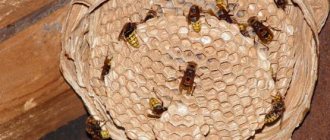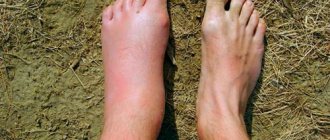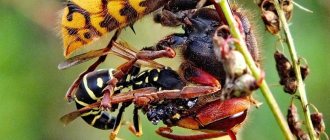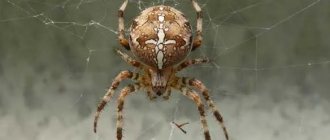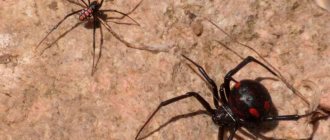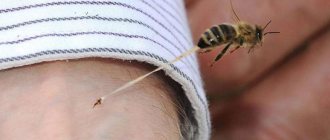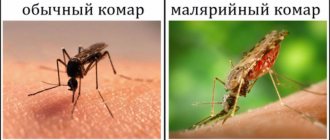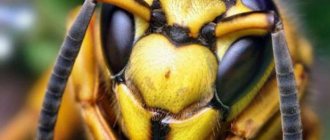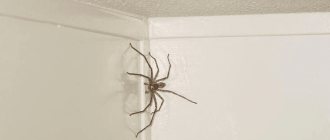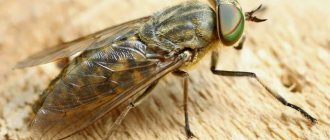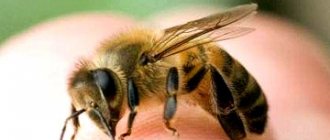A menacing buzzing makes many people anxious, and if something similar to a hornets’ nest appears in sight, there is a desire to get as far away from the dangerous place as possible. This is how people react to a potential threat. And this is correct, because the maximum risk of a bite occurs within a radius of 2–3 m from the nest.
Who is a hornet and why is it dangerous to humans? What to do if it bites and what could be the consequences? How to get rid of them and how do they differ from bees, wasps and bumblebees? Let's figure it out.
Who is the hornet
This is the largest representative of the so-called paper or social wasps. Their Latin name is Vespa, which literally translates as “wasp”. However, these are different insects that belong to the same family - true wasps.
Initially, no difference was made between the two representatives, and only in the 19th century the Vespa genus was divided into two groups. The description was based on several characteristics, but the main one was size - hornets are larger and can reach a length of up to 5.5 cm. Insects that are today considered wasps are designated in Latin as Vespula, that is, “small wasp.” Their size is 1.5–2 cm in length.
The hornet's threatening appearance is given by the bright coloring of its head - a combination of yellow, black, and orange.
The aggressive image is complemented by a striped belly, strong jaws and large eyes. However, these insects, unlike wasps, are non-aggressive. Human bites occur when a nest is disturbed or in self-defense.
Biological description
Hornets belong to the genus - social wasps. They live in families. A swarm can include up to several thousand individuals. Their life processes are clearly organized. Thus, within the “community” there are separate “castes” that perform specific functions.
The task of the hornet queen is to leave offspring. She is the leader of the colony. Females are born from fertilized eggs in August and September. Hornets reproduce by mating mature insects. After the females are fertilized, the males die.
The female stores sperm during the winter. With the onset of warm spring days, the queen begins to actively feed and regain strength in order to begin creating honeycombs for laying eggs. Thus, it forms the foundation of the future nest.
How long a hornet lives depends on its “profession”. Thus, males exist for one season, and the lifespan of the queen is a year.
The insect also has powerful jaws - mandibles. Literally speaking, hornets not only sting by injecting poison, but also bite. The insect uses mandibles to tear and grind prey.
During the active season, hornets feed on the juice of overripe fruits, trees, and honey. They hunt caterpillars, dragonflies, flies, spiders, related bees and wasps. They also cope with larger insects - crickets, locusts. There are descriptions of species capable of attacking birds and frogs. The prey is not used for food—the mass chewed and treated with saliva is used to feed the larvae.
Nests
The structure of a hornet's nest is based on hexagonal honeycombs.
The material is a substance similar to paper or cardboard. This is a lightweight structural element with thermal insulation properties of a brown color, which is obtained by mixing tree bark with insect saliva.
The place for the nest is chosen by the queen hornet. She does it where the offspring will be protected from excessive heat, cold and prying eyes.
Hornet nests reach 50–70 cm in length and are located in tree hollows, abandoned or used premises, cavities under roots, and piles of dead wood.
In the European Union, hornets are protected by law. For example, in Germany, the destruction of their nests is punishable by a large fine.
Area
Most species of hornets live in areas with a temperate climate, mainly in the northern hemisphere. Entomologists believe that they originally lived primarily in East Asia. There are several types of hornets on the territory of Eurasia, mainly the common and oriental ones.
People themselves play a major role in the spread of the insect. For example, a representative of the “common” species came to North America along with colonists from Europe in the middle of the 19th century.
In Russia, the hornet lives on a vast territory, which includes the European part of the Urals, Transbaikalia, the Amur region, and southern Sakhalin.
Kinds
Representatives of the extensive Vespa genus include more than 20 species.
- Affinis - small striped one.
- Analis - found in East Asia, measuring 25–28 mm.
- Basalis - basal.
- Bellicosa - warlike.
- Bicolor - two-color.
- Binghami - Binghama - active at night.
- Crabro - ordinary.
- Ducalis - commander's - one of the largest in Russia.
- Velutina is tropical, but also lives in Europe, as it was accidentally introduced there.
- Dybowskii - Dybovsky - almost monochromatic - black-brown.
- Fervida - ardent.
- Fumida - variable.
- Mandarinia is the largest in the world and also very poisonous.
- Multimaculata - multi-spotted.
- Orientalis - eastern.
- Philippinensis - Philippine.
- Luctuosa is tropical, found in the Philippines and is the most poisonous.
- Simillima - similar, very similar to the common hornet.
- Vivax - lives in Asia.
- Soror - black-tailed.
- Tropica - tropical.
Eight species of hornets live in Russia. The leader in occurrence is the “ordinary” (Vespa Crabro), which is distributed throughout almost the entire country, including the Moscow region. It is absent only in northern latitudes. The eastern hornet (Vespa Orientalis) lives in the Caucasus. In the south of the Far East, six species of Vespa are found - Simillima, Dybowskii, Ducalis, Mandarinia, Analis, Dinghami.
Role in nature
The benefits that hornets bring:
- destroy harmful insects that parasitize garden crops and wild plants - aphids, mites, psyllids;
- pollinate plants;
- They hunt locusts, flies, wasps, sick, “old” bees.
Natural enemies of hornets in nature limit their population within useful limits and destroy sick individuals. Among animals, these are ants, some species of birds (starlings, wagtails). Hornets are also susceptible to parasites - mites, nematodes, parasites and even microscopic fungi.
Interesting Facts
There are more than 20 species of hornets in the world, differing in color, behavioral characteristics, and size. The largest representative is the Asian one (Vespa Mandarinia), whose length exceeds 5 cm. In China, it is known as the “bee tiger”. Its venom contains a neurotoxin.
The hornet's queen releases pheromones that influence males. With their help, the “queen” organizes the activities of the entire swarm.
In the 18th century, the French naturalist, physicist and mathematician René Antoine Reaumur studied the material from which wasps build their nests. The result was a proposal to use wood in the production of paper, because until that moment, it was made from rags.
Biology
Asian giant hornets live in the same way as other “relatives” - in families or colonies. These insects make their nests in forests, often in close proximity to ponds and other sources of water. The construction of such a nest is started by the female - she lays the laid eggs in the first comb and raises the offspring that emerge from them on her own. During this period, she cares for the larvae, protects them and feeds them. After a few weeks, the larvae turn into young hornets, which take over all the responsibilities: they get food, cut up the bodies of caught victims, feed newly hatched larvae and protect the nest from enemies. The next grown hornets are already able to mate and reproduce.
On a note! The number of one colony can reach about 300 individuals, but even after this the female continues to lay eggs - all her responsibilities come down to this process!
Over time, the colony of Asian hornets is replenished with new males and females, and when their numbers become too high, they leave the overcrowded nest and mate outside it. Subsequently, fertilized females look for suitable places to build nests and become the founders of new colonies, and the males die.
Nest
To build nests, females use chewed pieces of young bark, which they fasten together using salivary secretions. At first, the nest has a very modest size - it is several cells with eggs laid in them. As the family increases in size, the nest also grows, gradually turning into a rather large gray cocoon, the height of which can reach 0.8 m and the width - 0.5 m.
The expansion of the nest and the development of hornets in it occurs throughout the warm season. With the arrival of the rainy season or with the onset of winter, all its inhabitants die, and the female stops laying eggs. Thus, the nest exists for no more than one year.
Nutrition
The basis of the diet of vespa mandarinia is food of animal origin - various arthropods. Adults, unlike larvae, can also eat berries, fruits and fish carcasses washed ashore.
Japanese giant hornets very often raid the nests of their small “relatives”: more often bees, less often wasps and hornets of other species with more modest body sizes. At the same time, the hunters act with particular cruelty, destroying the entire nest and killing absolutely all its inhabitants. The prey includes bee larvae and pupae, as well as sweet honey. The hornets take all the trophies to their nest, where they later use them for their own food and survival.
On a note! A small flock of Asian hornets (30-40 individuals) is capable of destroying a bee colony of about 20-30 thousand individuals in just a couple of hours!
It is noteworthy that the huge Asian hornet, having a very poisonous sting, practically does not use it for hunting. It kills prey with the help of powerful jaws located in the front of the head - with them the hornet easily splits the chitinous covers of its victims. Thus, bees, modest in size, turn out to be very easy prey for these giants, and are unable to withstand several hornets.
Apiary owners usually combat these winged pests using radical measures. They find a nest and burn it, drown it, or destroy its inhabitants with insecticides. The main thing in this matter is to be able to get as close to the enemy’s lair as possible and remain unnoticed. But sometimes bees find a way to protect themselves, but they succeed only when only one hornet, the scout, penetrates the hive. The bees surround the stranger and very quickly create a cocoon around him. As a result, the hornet dies from high temperature. If the scout remains unnoticed, then he marks the hive with his secret and after a while arrives with reinforcements.
Why is a hornet dangerous for humans?
The following components of the poison pose a danger to humans:
- phospholipase A2 is an enzyme that activates the inflammatory response;
- acetylcholine is a neurotransmitter that ensures the transmission of impulses;
- histamine is a mediator of immediate allergic reactions;
- mastoparan is a toxin of protein origin.
As a result of the influence of a “bouquet” of biologically active substances on the tissues of the human body, a protective systemic inflammatory response develops.
A hornet sting can be fatal to humans if the victim experiences an allergic reaction. The following complications may also develop:
- skin rashes;
- bronchospasm - obstruction of the airways with difficulty exhaling;
- hallucinations;
- paroxysmal pain in various parts of the abdomen, nausea, vomiting;
- convulsive syndrome;
- depression of consciousness;
- a sharp decrease in blood pressure with further cessation of blood circulation.
Single hornet bites during pregnancy and lactation do not pose a danger to the fetus and infant, since the amount of poison is insignificant to penetrate the placental barrier or into the liver of a nursing mother.
How dangerous is a hornet bite for a child? Due to the small body weight, the concentration of poison for his body is very high, so the symptoms are more pronounced. And also due to the fact that children react actively and unpredictably to buzzing insects, the risk of multiple attacks increases, increasing the development of allergic reactions. In order not to risk the child’s life if bitten, you should immediately call an ambulance, without waiting for allergies to appear and anaphylactic shock to develop.
Hornet venom and its effect on the body
The poisonous substance injected by the hornet under the skin of the victim is protective in nature, which explains the painfulness of the bite. The components that make up the poison are found in rattlesnakes and other representatives of the animal world. The most dangerous components include:
- Acetylcholine. Activates nerve endings. Once in the tissue, it leads to irritation of nerve nodes, the occurrence of impulses and severe pain in the affected area.
- Phospholipase A2. A combination of enzymes that destroy cell walls. This substance is similar to a component of snake venom. Leads to vascular damage, hemorrhage, and the formation of suppuration.
- Orientotoxin. Dissolves cell membranes, allowing their contents to exit into the intercellular space. Destroys cellular structures.
- Histamine. Activates a rapid allergic reaction.
- Mastoparan. Releases histamine.
- Mandorotoxin. Blocks the functions of the nervous system.
- Biogenic amines. They provoke disruptions in the functioning of the respiratory and cardiovascular systems. Cause arrhythmia and difficulty breathing.
The remaining components act as catalysts, enhancing the reaction of tissues, accelerating the process of distribution of toxic substances.
Causes of a hornet sting
The main reason for a hornet bite is self-defense, and it always tries to get away from a person first and stings only if it is grabbed.
The insect uses its sting only for the purpose of protection or to neutralize a resisting victim. Entomologists explain that hornets will not consume poison without justified biological expediency. After all, this is a valuable weapon that is necessary during hunting.
Having detected a threat, hornets release alarm pheromones, which call on other individuals to attack. Therefore, everyone who is within a radius of 2–3 meters from a disturbed nest or a killed hornet will be bitten.
Bite symptoms
The hornet does not leave a sting when it bites, so it can sting several times. This feature distinguishes it from bees. A large number of bites can be fatal to humans. Especially if you are allergic to wasp venom.
Symptoms that develop from a hornet bite:
- sharp, severe pain;
- swelling, redness;
- itching, burning at the bite site;
- increase in body temperature to high numbers;
- possibly manifestations of allergic reactions, including anaphylactic shock.
Actions to take if bitten at home
Every person needs to know how to act in cases of bites of various stinging insects, including hornets. As a rule, most people begin to panic, not knowing how dangerous the bite of this insect is. Such a reaction leads to serious negative consequences. Therefore, it is important to know how to properly provide first aid to the victim, but for this you need to know the signs of various allergic reactions.
How to act in such conditions:
- A person prone to allergies should carry any antihistamines with him.
- Allergy sufferers should carry with them a medical document indicating the nature of the allergic reactions that a person exhibits as a result of a bite, as well as information about medications that help in such situations.
- Immediately inform family and friends about the victim of a hornet sting in order to be aware of the possible consequences if the victim does not have the information.
First aid
In the event of a hornet bite, it is necessary to implement a number of measures that will help get rid of the negative consequences. For example:
- Take the victim away from the place where the hornet carried out the attack, sit him in a comfortable position, unfasten the collar and loosen the belt.
- The hornet does not leave a sting, so you should not look for it.
- If the hornet was killed during a bite, then fragments of the sting may remain in the wound. In this case, it must be carefully removed in the most accessible way, disinfecting both the instrument and the wound itself.
- The affected area must be treated with an antibacterial agent, such as a slightly pink solution of potassium permanganate.
- Wipe the bite site with any alcohol solution. This could be vodka, moonshine, cologne, eau de toilette or medical alcohol.
- After this, ice or something cold is applied to the bite site.
- The victim should take an antihistamine to avoid allergic reactions.
- If a severe allergic reaction occurs, immediately take the victim to the hospital or call an ambulance.
How to properly treat a bite site:
- All movements should be clear, but light, without pressing on the bite site.
- The treatment product should be applied carefully with light movements.
- Under no circumstances should you squeeze out the poison, as it will no longer be present at the point of the bite.
- Before processing, you must wash your hands thoroughly with soap to avoid infecting the wound.
What is unacceptable to do:
- Apply pressure to the bite site.
- Rub the affected area.
- Cauterize the wound.
- Warm up the swollen area.
- Treat with iodine or brilliant green.
ethnoscience
As a rule, traditional medicine mainly uses natural ingredients. When people go on vacation, into nature, they can take with them tablets against diarrhea or against rapid digestion of food, but not against the bites of various insects, although if you are extremely careful, you can hardly feel the stings of bees, wasps or hornets, God forbid. But in nature, some plants that are always at hand will help overcome the consequences of bites. If a hornet bites you at home, you can also use traditional medicine.
The following plants can stop the spread of swelling and redness:
- Aloe juice or pulp.
- Plantain juice or leaf.
- Chopped parsley (greens).
Cooking method:
- The bite site is washed with clean water.
- After this, a plantain leaf, plantain or aloe juice, or a gruel of chopped parsley is applied to the bite site.
- Before this, the greens must be thoroughly washed.
- After applying the product, cover the bite site with a clean piece of cloth, gauze or bandage. Every 20 minutes it is necessary to change the compress or reapply plant juice.
On a note! In any case, you will need an allergy pill. If this happened in nature and no one had an allergy pill, and the victim was quite ill, then he would quickly have to be taken to a nearby hospital or try to call an ambulance. Therefore, when going out of town for a picnic, you should always take antihistamines and disinfectant liquids with you.
Medicines for allergic reactions
There is a category of people whose body reacts negatively to the bites of various insects. A person who knows about his problems should always have with him products that help against allergies.
This is especially important in conditions where a person is in nature and there are no medical facilities nearby. In such conditions, every minute counts, especially when stung by a hornet, whose poison concentration is always higher than that of a wasp or bee.
Antihistamines should always be in your home medicine cabinet, as they can save health, and maybe even life, in cases of stinging insect bites. The most effective are 3rd and 4th generation products. These are drugs that do not cause drowsiness and act throughout the day.
Commonly used allergy remedies
Please pay attention to:
- Suprastinex.
- Fexofenadine.
- Cetrin.
- Claritin.
- Erius.
The following medications are suitable for treating the bite site:
- Fenistil-gel.
- Balm “Rescuer”.
- Fluorocort.
- Psilo-balm.
A special role should be given to sorbents, which reduce the concentration of poison in the human body, which leads to a reduction in negative consequences.
The following remedies have a similar effect:
- Polysorb.
- Enterosgel.
- Smecta.
- Activated carbon.
- White coal.
First aid
What to do if bitten by a hornet? It all depends on where and under what circumstances it happened. It is important to protect people from mass attacks. The biological instincts of insects are aimed at survival, which means protection from external invasions. If there is a nest within 2–3 m, you must immediately leave the danger area. When indoors, you should close the windows and make sure there are no insects.
If a hornet bite occurs, the algorithm for providing first aid at home should be as follows:
- examine the wound;
- if a sting remains, for example, after hitting an insect, then carefully remove it;
- do not try to squeeze out the poison;
- suck out the contents of the wound as quickly as possible;
- treat the bite site with an alcohol wipe or liquid;
- to relieve pain and swelling, apply “cold”;
- if there are indications, then take an antiallergic drug, for example, Suprastin or Tavegil.
When treating a hornet sting at home, it is important to continue to monitor the condition of the victim. If alarming symptoms appear, you should consult a doctor.
What to do if a hornet bites a child? The algorithm of actions for providing first aid is the same as for adults. Then you need to calm the baby down, distract him from the unpleasant incident and seek the advice of a medical specialist. Incorrect assessment of symptoms, potential complications, and self-medication can significantly worsen the child’s condition.
Why do some people think hornets don't have a sting?
If the insect is in a calm state, then the presence of a sting is almost impossible to notice. Because they have a distinctive coloration that warns others of danger, members of the colony can live without worries. They are not afraid of anyone and are one of the most dangerous predators - flies, grasshoppers, and spiders suffer from them. But they bring special problems to beekeepers, because when attacking a hive, they are capable of chewing through a couple of colonies of honey bees.
When flying out to “hunt”, they use strong jaws that help them cope with prey. If you have ever encountered a dangerous insect, you will definitely not forget the view from the large striped body, the large head with impressive eyes, and the sound of the buzzing of the porches. Their jaws can bite through a child's thin skin, causing severe pain.
But, of course, most often they use their sting for defense and attack. So they have a special structure of muscles, segments at the end of the abdomen, their sting can easily hide inside it and, if necessary, move out in a split second.
Treatment
In the International Classification of Diseases, Tenth Revision ICD-10, a hornet sting is designated by code W57 - stinging by non-venomous insects and arthropods.
There is no specific antidote for a hornet sting. Therefore, treatment includes the use of the following drugs:
- analgesic;
- antihistamine;
- antipyretic;
- decongestant.
If life-threatening complications develop, intensive therapy is carried out in the intensive care unit.
If a hornet bites you on the head, namely, in the area of the face or neck, swelling may develop that affects the airways. This condition threatens the life of the victim and requires treatment in a hospital. Airway obstruction is an indication for hospitalization in the intensive care unit. Intensive therapy includes the administration of glucocorticosteroids (hormones of the adrenal cortex), diuretics, and, if necessary, connection to a ventilator.
Consequences
- children;
- elderly and senile people;
- patients with a history of allergies, chronic diseases of the heart, blood vessels, and respiratory organs.
The severity of symptoms and the possibility of developing complications depends on the health status of the victim.
If there was no allergic reaction of the body, then the inflammation caused by the hornet sting goes away in a few days. This can be judged by the reduction in swelling, redness, and pain in the wound area.
The damaged area may itch for some time. How to relieve itching after a hornet bite? It is enough to apply cold. If this is one of the symptoms of an allergic reaction, then you should consult a doctor who will prescribe antihistamines.
Folk remedies and recipes
Mallow
To alleviate the condition and relieve unpleasant symptoms in the bitten area, folk recipes that consist of applying to the damaged area also help well:
- a damp sugar cube, on which a wet towel is placed on top (the procedure is carried out for 10 minutes to draw out the poison, after which a compress is made with lemon juice);
- halves of onion or garlic clove;
- sour juices and solutions - squeezed lemon juice, vinegar (apple or table), half an apple, etc.;
- mashed leaves of medicinal plants: parsley, plantain, mallow, marigold.
To relieve edema and swelling, it is recommended to use compresses using the following solutions:
- Lemon: ½ tsp. citric acid per 150–200 ml of water, ½ cup of vinegar.
- Medicinal: ½ tsp. ammonia, ½ tsp. citric acid, 160–220 ml of vinegar or brandy.
Soak a handkerchief or cloth with the resulting solution and place it on the affected area. The compress should be changed 5-6 times until the swelling and redness subside.
How to get rid of hornets
Smells that repel them:
- soapy;
- essential oils contained in red hot pepper;
- aroma of mint, geranium, basil, wormwood;
- smoke.
If a hornet has flown into a room, it will explore the space in search of a way out until it finds one. Therefore, to get rid of it in a house or apartment, the best solution is to simply open the window wider and allow it to get out. If you try to catch it using a jar or vacuum cleaner, there is a chance of being bitten.
Remedies for hornets:
- insecticides - Get, "Medilis-Super", "Delta-Zone", aerosol from wasp nests Mosquitall;
- traps - Argus Garden, Swissinno Wasp Trap;
- smoke bombs - “Mukhoyar”, “Quiet Evening”, “FAS”, “City”;
- ultrasonic or acoustic insect repeller - EcoSniper LS-989, Sititek Flash, Grad Ultra 3D, Weitech WK-0180;
- insecticidal lamps - Well, Mo-El, Hilton.
What else are hornets afraid of? They are repelled by plants - basil, geranium, mint, lemon balm, wormwood, hanging red pepper pods. With their help, you can get rid of hornets in your garden, yard or attic of a private house. It is enough to plant or lay out dry plants near the nest and after a while the insects themselves will prefer to move to another place.
Difference from bee, wasp, bumblebee
| Wasp | Bee | Bumblebee | Hornet | |
| Size(cm) | 2,0–3,5 | 2,1–3,9 | 1,3–2,8 | Up to 5.5 |
| The structure of the sting | smooth | has jagged edges | smooth | smooth |
| Painful bite | The pain from a hornet sting is comparable in intensity to the sting of a wasp, bee or bumblebee. | |||
The hornet can also be confused with other insects.
- The gadfly is distinguished by its smaller size and color, which is dominated by gray and black shades. It belongs to synanthropic flies. Only one species attacks humans: the human skin botfly, which lives in Central America.
- The difference between Scolia and Hornet is in size. Its length is about 3 cm in females and 4.5 cm in males. There is also a difference in color - Scolia is almost all black, with only two yellow spots.
- A drone is a male honey bee. The difference from the hornet is in size (no more than 1.5–1.8 cm), less bright color and lack of a sting.
Let's summarize. The hornet is a large, brightly colored insect from the genus of social wasps. It has jaws and a sting hidden at the tip of the abdomen. People are bitten most often due to the instinct of self-preservation. This is facilitated by the fact that nests are often created in close proximity to human habitation. The consequences of a hornet sting are dangerous due to the appearance of an allergic reaction, with possible death from anaphylactic shock. Especially if the insect stung several times or a child, an elderly or senile person was injured. In this case, you should definitely seek professional medical help. If there was no allergy, then the inflammation goes away within a few days.
How do they reproduce and how long do they live?
The queen, hibernating in the cold, finds a place in the spring that is suitable for a nest and lays her eggs there. She then looks for food and looks after her future inheritance.
After about thirty days, hornets emerge from the larvae, and it is possible that the queen will be expelled from the nest, or eliminated, because she can no longer lay eggs.Newly born members of the community take care of the future arrangement of the nest and feeding the queens and larvae. This type of scheme causes the community to grow incredibly quickly.
As for the duration of the hornets’ life cycle, it only reaches a couple of months. We are talking about working insects.
But the queen can live longer due to the ability to withstand severe frosts well, thanks to hibernation.
